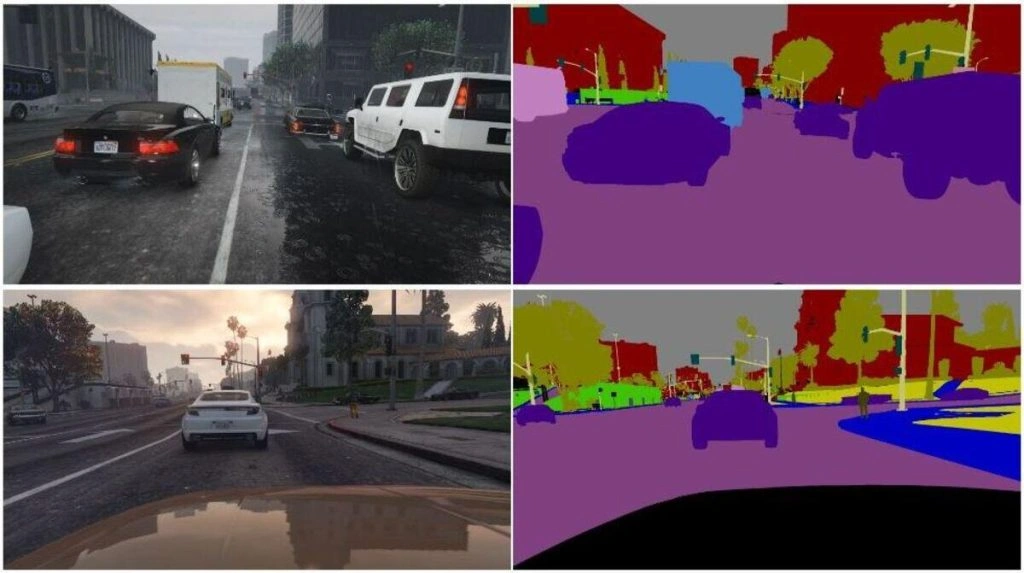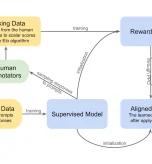Even as processing power increases exponentially and machine learning algorithms become more accessible, a persistent challenge continues to slow the development of complex AI: obtaining high-quality, accurate training data.
All supervised machine learning algorithms require training data, yet high-quality data itself is a somewhat finite resource.
The challenge is how to efficiently obtain enough quality data to train and optimise your model. And what if obtaining real training data isn’t even an option?
Synthetic data might be the answer – and in 2025, it’s becoming essential rather than optional.
What is Synthetic Data?
The principle behind synthetic data is simple – you generate it instead of gathering real data.
No longer just a stopgap solution for data shortages, synthetic data has become a sophisticated strategy for generating artificial information that mirrors real data’s all-important patterns and features.
According to recent market projections, the global AI training dataset market is expected to reach USD 18.9 billion by 2034, growing at a CAGR of 22.2% – a clear indicator of the growing demand for high-quality training data.
Synthetic data isn’t a new concept, as for some machine learning applications, obtaining high-quality real data in the required proportions is either very tricky, impossible, or in no way cost-effective.
Here’s an example: Suppose you’re training computer vision AI for life on Mars. You may be able to feed in some images from the Spirit and Opportunity rovers that travelled to Mars, but it wouldn’t be enough. You’d need to supplement them with additional synthetic images to create a richer, more diverse training set.

Moreover, training models in controlled environments makes engineering a computer’s understanding easier in any scenario you deem essential. For instance, an autonomous vehicle manufacturer concerned about performance in foggy conditions doesn’t need to rely on limited real-life foggy road driving data – they can create realistic computer-generated scenarios instead.
For generative AI, LLMs and other frontier models somewhat ‘know everything’ if ‘everything’ is published on the internet in some form (which it’s not; at least it’s arguable).
But, LLM performance benefits from more info than the internet can give, especially on topics with low coverage. As Elon Musk recently observed, “The cumulative sum of human knowledge has been exhausted in AI training.”
While hyperbolic, it highlights the growing reliance on synthetic alternatives as we’ve begun to exhaust readily available high-quality human-generated content.
Current Synthetic Data Generation Methods
What began as relatively simple statistical techniques has blossomed into a sophisticated ecosystem of AI-powered methodologies, each with distinct strengths and applications.
Here are four core strategies for generating synthetic data:
GANs (Generative Adversarial Networks)
GANs remain powerful for generating realistic synthetic data. They use two competing neural networks – a generator creating fake data and a discriminator identifying it as fake – to progressively improve output quality.
GANs excel at producing high-fidelity images and are widely used for creating realistic game characters and visual content. However, they still struggle with mode collapse (producing limited varieties of outputs) and training stability.
In practical terms, GANs have proven particularly valuable for generating synthetic images for computer vision training.
For example, when a retail company needs to train inventory management AI but lacks sufficient images of products on shelves in various lighting conditions, GANs can generate thousands of realistic variations, significantly improving model performance.
VAEs (Variational Autoencoders)
VAEs use an encoder-decoder architecture to learn compressed representations of data. They’re particularly effective for dealing with structured data and work well with smaller datasets.
VAEs provide high diversity in outputs but often produce ‘blurrier’ results compared to GANs – making them better suited for applications where overall distribution accuracy matters more than visual clarity.
For instance, in healthcare applications, VAEs can generate synthetic patient records that maintain the statistical relationships between different health metrics whilst completely anonymising the original data.
This enables researchers to share datasets without privacy concerns with the intention of accelerating medical research whilst protecting patient confidentiality.
Diffusion Models
The rising stars of synthetic data generation, diffusion models, have revolutionised image synthesis.
Rather than creating images in one step, these models start with random noise and gradually refine them into coherent, detailed images through denoising. While computationally intensive, diffusion models offer both exceptional high fidelity and diversity, making them increasingly popular for image generation tasks requiring photorealistic quality.

Their ability to create highly detailed synthetic images has proven key for industries where highly detailed synthetic imagery is critical.
Transformer-Based Language Models
For text-based synthetic data, large language models (LLMs) built on transformer architectures have become indispensable.
Models like GPT-4, but tuned for synthetic data creation, can generate synthetic text data ranging from simple responses to complex documents that maintain required style, tone, and factual relationships.
Companies like OpenAI, Google, and Anthropic use these models to generate synthetic training data for smaller, more specialised language models. This helps address data scarcity in niche domains while maintaining privacy by avoiding the use of potentially sensitive real text data.
However, there are many risks for training LLMs on AI-generated data, such as compounding hallucination risks, introducing and emphasising biases, and eroding model quality over time.
Agent-Based Simulation
For complex behavioural and interaction data, agent-based simulation has emerged as a powerful technique. This approach models individual entities (agents) with defined behaviours and allows them to interact within a simulated environment, generating synthetic data about their interactions.
This method is particularly useful in domains such as urban planning, epidemiology, and financial market modelling, where the interactions between multiple actors create complex emergent patterns that are difficult to capture otherwise.
For example, transportation companies can simulate thousands of vehicles moving through a city to generate synthetic data for optimising route planning algorithms, without needing to collect expensive real-world tracking data.
The Business Case for Synthetic Data
Beyond the technical aspects, synthetic data presents compelling economic and strategic advantages for organisations across industries.
The business case has strengthened considerably as the technology has matured, making synthetic data a technical solution and a business imperative for the AI sector.
Cost-Efficiency
A Deloitte report recently claimed that synthetic data results in an 80% faster data generation, and up to 95% cost reduction.
AI startup Writer claims its Palmyra X 004 model, developed using almost entirely synthetic sources, cost just £550,000 to develop – compared to estimates of £3.6 million for a comparably sized OpenAI model.
It’s worth highlighting that speed and cost in the data engineering stage do not always equate to lower costs across the entire project lifecycle.
Nevertheless, for many companies, the most expensive part of AI development isn’t the computing infrastructure or even talent – it’s the acquisition and preparation of high-quality training data.
Synthetic data dramatically reduces these costs, particularly for applications requiring massive datasets that would be prohibitively expensive to collect manually.
Legal Protection
Real data is often harvested without explicit permissions. Or, at least, the rules are hazy – hence why companies like OpenAI, Anthropic, etc, are currently locked in many lawsuits regarding alleged illicit data collection practices.
Synthetic data offers a solution that leapfrogs legal issues. If synthetic data is created by a machine, then training a secondary AI system with synthetic data would not violate anyone’s particular copyright or other IP rights.
This inherent legal advantage has become much more important as copyright disputes around AI training data intensify. Organisations can reduce exposure to potential litigation by incorporating synthetic data into their training pipelines, particularly for generative AI applications where copyright and privacy concerns are most acute.
Addressing Data Scarcity
Major AI companies, including OpenAI, Google, and Anthropic, are all struggling to locate enough high-quality training data for their most advanced models.
Synthetic data provides a way to overcome these limitations and continue pushing AI performance forward through bottlenecks.
Besides LLMs and frontier models from the top companies, synthetic data may be the only viable strategy for building effective AI systems for specialised domains where data is naturally scarce, such as rare medical conditions, challenging road conditions, or unusual manufacturing defects.

By generating synthetic examples of these rare cases, organisations can train models that perform well even on infrequent but important scenarios.
Synthetic Data Use Cases
The practical applications of synthetic data have expanded dramatically as the technology has matured. Today, it’s viable to generate lifelike synthetic data with even highly precise features and variables.
With that said, synthetic data still excels in some domains more than others. Here are some examples of when synthetic data is invaluable or indispensable:
1: Agile Data Projects
For fast-moving industries where businesses need to provide data to third parties, synthetic data negates the regulatory lag of negotiating deals involving sensitive information.
Moreover, personally identifiable information (PII) – very common in medicine, telecoms, and customer service – is subject to numerous privacy and data protection rules. As mentioned above, synthetic data practically circumvents all of those issues.
Consider a fintech startup developing a fraud detection system. Rather than waiting months for partnership agreements with banks to access real transaction data, they can generate synthetic financial transactions that mirror the patterns of fraudulent and legitimate activities.
2: Training in Safety-Critical Environments
For applications like autonomous vehicles, synthetic data allows for testing in rare but dangerous scenarios that would be impractical or unethical to create in real life. Companies like Waymo and Cruise use synthetic simulations to generate LiDAR data, representing an empirical ground truth while allowing for extensive scenario testing.

This technique touches on other safety-critical domains like aviation, industrial robotics, and medical devices. When the cost of failure is human safety, synthetic data enables comprehensive testing of edge cases and rare scenarios without putting real people at risk.
3: Monetisation
Monetising valuable real datasets presents legal and regulatory issues regarding privacy, anonymity, and intellectual property rights. Synthetic data negates many regulatory barriers to dataset monetisation, opening new revenue streams for data-rich organisations.
Companies that possess valuable proprietary data can create synthetic versions that capture their expertise without exposing the original information. Essentially, you use real data to spin out synthetic versions.
For example, a retailer with extensive customer purchase data could generate synthetic shopping patterns that capture valuable consumer insights without exposing actual transaction records.
This synthetic dataset could be sold to suppliers or market research firms, creating a new revenue stream from an existing asset – though such data would obviously be highly commercially sensitive, and thus, kept on a tight leash.
The Pros and Cons of Synthetic Data in 2025
As with any transformative technology, synthetic data presents both significant advantages and notable challenges. Just because we can generate good synthetic data doesn’t mean that we should generate and use synthetic data.
Here are the pros and cons of synthetic data:
Pros of Synthetic Data
1: Scale
One of the most challenging elements of any machine learning project is obtaining enough data. Synthetic data enables AI teams to tackle the issue of scale – as many training images can be generated as needed. Moreover, synthetic data is often auto-labelled, saving tremendous time.
LLMs and computer vision systems typically require millions or even billions of training examples to achieve high performance. Synthetic data generation can meet these massive requirements when collecting real data at such a scale would be impractical or impossible.

2: Privacy and Regulation
Real-world data is subject to laws and regulations regarding privacy and data usage, such as GDPR. Synthetic data solves confidentiality and privacy issues without compromising quality in sensitive industries.
As regulatory scrutiny of data usage intensifies globally, synthetic data offers a path forward that balances innovation with compliance.
By generating artificial data that preserves statistical relationships without containing any actual personal information, organisations can build powerful AI systems whilst avoiding privacy pitfalls.
3: Value
Real-world data can be free, but it can also be costly. Synthetic data isn’t always cheap to generate, but often has the edge over purchasing expensive datasets, especially for specialised use cases.
The economics become particularly favourable for specialised applications where relevant real data is scarce or expensive.
4: Flexibility and Control
Synthetic data can be engineered with specific user-controlled characteristics that can scale to the complexity of the model. If a feature isn’t present in a dataset, it can be added later, giving developers superb control over training data composition.
This control extends to addressing bias and fairness concerns in AI systems. By carefully designing synthetic data generation processes, organisations can ensure representative distribution across sensitive attributes like gender, ethnicity, and age – sometimes more effectively than with real-world datasets that may reflect historical biases.
Cons of Synthetic Data
1: Complexity
Even the latest high-grossing video games from top publishers still aren’t truly realistic.
Replicating the real world remains challenging, and synthetic data engines are still ‘good enough’ rather than perfect replacements for real data.
However, it depends on the data in question. While generating synthetic consumer transactions might be relatively straightforward, accurately simulating complex physical systems or human behaviour remains a real conundrum.
2: Risk of Model Collapse
There’s growing concern about model collapse, where a model becomes less “creative” and more biased in its outputs when trained primarily on synthetic data (aka recursively trained), thus compromising functionality over time.
Suppose you train LLMs on non-natural AI-generated writing repeatedly (which is likely happening right now). Eventually, quality is eroded, and the AI struggles to produce lifelike ‘human’ text.
In fact, eventually, the concept of high-quality human writing could be totally lost to such a system. It will merely self-perpetuate its own non-realistic and sometimes biased or inaccurate assumptions.
3: Computational Costs
While cheaper than collecting real data in many cases, generating high-quality synthetic data still requires significant computational resources, especially with diffusion models. This can make the process highly expensive for smaller organisations.
Plus, producing the best synthetic datasets still takes time, expertise, experimentation, and trial-and-error.
4: Trust and Validation
A model trained on high-quality, well-annotated real-world data is often more trustworthy in high-stakes situations. The process of validating that synthetic data accurately represents real-world phenomena remains tricky, especially for complex domains.
In critical applications like healthcare diagnostics or financial risk assessment, stakeholders may be reluctant to trust systems trained primarily on synthetic data without extensive validation against real-world performance.
The Future: Where Synthetic Data is Heading
The future of synthetic data isn’t just about generating more of it – it’s about generating it more intelligently. As organisations move beyond experimentation, we’re seeing sophisticated approaches emerge that blend technical innovation with practical business needs. Three key developments stand out:
- Integration with Real Data: Leading AI labs are using larger models to generate synthetic data to train smaller, more efficient models. This strategy, called “distillation” or “knowledge transfer”, enables more efficient AI deployment whilst maintaining high performance. The largest models function as teachers, generating synthetic data that captures their skills and knowledge for training more compact student models.
- Standardised Evaluation Methods: The industry is developing robust frameworks to evaluate synthetic data quality. As the United Nations University notes, “We cannot assume synthetic data to be automatically better or equivalent to real-world data” – highlighting the need for standardised evaluation methods that combat pressing questions about data representation, relationship preservation, and bias detection.
- Regulatory Frameworks: Organisations and governments are developing guidelines for responsible synthetic data use in AI training. Rather than using synthetic data to circumvent compliance, these frameworks encourage practices that align with data protection principles whilst enabling innovation.
Does Real Data Still Have the Edge?
For the majority of projects, real data does still have the edge over synthetic data, though they are both well-suited to different situations.
Creating synthetic data is simply not always possible or appropriate for certain ML projects, and the reverse applies to real data.
For example, Aya Data sourced and labelled images of maize diseases to help our client build a disease classification application. Creating synthetic data wouldn’t have been an option here – the project required real images of maize disease.
Synthetic data solves the issue of scale in projects that require vast quantities of simple data.
Still, the narrative that synthetic data will solve the problems associated with large-scale ML projects belies the challenges of working with data that is inherently limited by what has already been observed and captured, and the imagination of its creator.
Moreover, while humans operate the controls of synthetic testing and training environments, the issue of bias and misrepresentation must be carefully monitored.
Overall, synthetic data unquestionably has a growing place in machine learning, particularly for enterprise-level projects that require a multitude of data points. On the other hand, many cutting-edge, creative, or novel applications of ML require at least a portion of real data, and always will do.
To learn more about Aya Data, our data acquisition services, and what we can do for your AI and machine learning projects, please contact us today.






